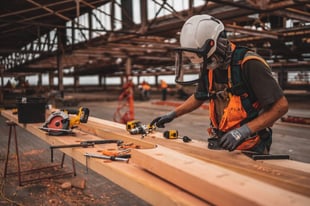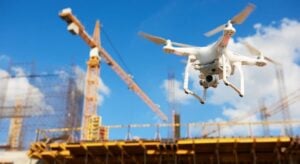The Acceleration of Construction Tech is Not Slowing Down
The construction industry has long been known for its resistance to change and slow adoption of digital technologies. However, in recent years, the landscape has started to shift. The architecture, engineering, and construction (AEC) sector is undergoing a surge of digitalization and innovation as a result of a high demand for infrastructure, a lack of trained labor, and rising pressure from stakeholders for data openness and integration. In this article, we will explore the trends that are accelerating the digitization of the AEC industry and discuss strategies for AEC tech companies to achieve efficient growth.

See also: Smart Cities Require Smart Construction
The digitization of the AEC industry has been gathering momentum over the past decade, with the pace accelerating in recent years. Several economic factors and regulatory changes are prompting investment in AEC tech, fueling the growth of the industry. Let’s take a closer look at these trends:
Global demand for long-term construction is on the rise, driven by increased government stimulus and investments in infrastructure. Initiatives such as the Bipartisan Infrastructure Law in the United States, which will cost $1.2 trillion, and the NextGenerationEU fund in Europe, which would cost $800 billion. Additionally, asset owners are investing in decarbonization efforts to make their portfolios more climate resilient. These factors are creating a need for digital technology to increase productivity and bridge the gap between the supply and demand of skilled workers.
The tsunami of digitalization that is sweeping across the AEC sector is also being bolstered by changes in regulatory policies. For instance, the Building Safety Act in the United Kingdom requires a digital ledger of all building data for newly constructed residential structures, but the ID06 law in Sweden stipulates the keeping of digital records of construction employees on a construction site. These rules are encouraging the adoption of digital tools and procedures, which will ultimately result in the sector becoming more connected and productive.
The amount of money invested in AEC technology has multiplied, and according to our research, an increasing number of investors are beginning to see the potential of AEC technology to radically alter the structure of the construction sector and redistribute value pools on a massive scale. It is probable that this momentum will continue. Seventy-seven percent of those who took part in our poll anticipate making the same amount of investment or more in AEC technology in 2023, and sixty-four percent believe that it will generate greater returns in comparison to other verticals.
With a surge in late-stage venture financing and M&A activity, the AEC tech sector is maturing. AEC technology received $11.5 billion in late-stage venture capital investment between 2020 and 2022, which is more than treble the sum allocated over the preceding three years. M&A, which accounts for 48% of all investments and 68% of all exits, continues to be the main source of finance for AEC digital firms. The higher median deal size and post-money valuation since 2017 both show the industry’s expansion.
By providing solutions that cover a variety of use cases, AEC tech businesses are attempting to solve the problem of client fragmentation. Due to customer need for interoperability, close to half of the examined AEC tech businesses provide solutions that meet three or more use cases. One-stop-shop platforms created by bigger AEC software businesses as well as virtual platforms built utilizing open standards and processes, such openBIM, are enabling seamless collaboration and integration throughout the industry.
In addition, property technology (proptech) and AEC tech are merging. While proptech concentrated on the funding, planning, operation, and maintenance elements, AEC tech historically concentrated on the design and building of assets. However, the importance of linking the two ecosystems is becoming more widely acknowledged. The use of digital twins to integrate the design and operation of building management systems is one of the proptech use cases that AEC tech firms are increasingly tackling.
Despite tremendous investment and expansion, there remain obstacles to effective scalability and growth in the AEC tech sector. Let’s examine these challenges:
With the average construction business employing less than 10 workers and each project needing a large number of suppliers and subcontractors, the construction industry is extremely fragmented. Because of this dispersion, scaling for AEC digital businesses is labor-intensive and slow. development requires selling to many of different businesses, but this risk-averse and fragmented industry might be reluctant to change, which will restrict development even further.
See also: The Upcoming Trends of Construction and Technology
Due to the confusion between user and buyer personas, identifying the true client in the AEC sector can be difficult. The customer may be the project manager, IT manager, or procurement manager, depending on the project. Rather than at the corporate level, purchase decisions are frequently made at the project level, necessitating that businesses resell their products for every new project. Net retention suffers as a result, and acquisition expenses rise. Successful businesses have a strategy for selling to the company as a whole, not simply the project.
Low profit margins and growing economic headwinds, such as rising material costs, are characteristics of the construction business. Due to their restricted investment capacity, AEC businesses spend less on IT than those in other sectors. In a low-margin sector, it is critical for AEC tech businesses to show how their technologies save money. Although the return on investment may be substantial, it has been difficult to accurately measure these advantages.
First Reported on: McKinsey
Frequently Asked Questions:
Q: What is construction technology?
A: Construction technology refers to the application of innovative tools, equipment, materials, and techniques to improve the efficiency, safety, and sustainability of construction projects. It encompasses various fields such as building design, project management, construction methods, and the use of advanced technologies.
Q: What are some examples of construction technology?
A: Some examples of construction technology include Building Information Modeling (BIM), 3D printing, drones, virtual reality (VR), augmented reality (AR), prefabrication and modular construction, robotics, laser scanning, and advanced materials like self-healing concrete and energy-efficient building systems.
Q: How does Building Information Modeling (BIM) benefit the construction industry?
A: BIM is a digital representation of a building project that integrates 3D modeling, data management, and collaborative tools. It allows architects, engineers, contractors, and other stakeholders to work together more efficiently, detect clashes or conflicts in designs before construction, improve cost estimation, enhance project visualization, and streamline the overall construction process.
Q: How can drones be used in construction projects?
A: Drones are commonly used in construction for surveying, site inspections, and monitoring project progress. They can quickly capture high-resolution aerial images and create accurate topographic maps, track stockpiles of materials, monitor worker safety, and perform inspections of hard-to-reach areas, such as rooftops or tall structures.
Q: What are the benefits of using prefabrication and modular construction?
A: Prefabrication and modular construction involve constructing building components off-site in a controlled environment, and then assembling them on-site. This approach offers benefits such as reduced construction time, improved quality control, cost savings, minimized material waste, and increased sustainability.
Q: How can 3D printing be used in construction?
A: 3D printing, also known as additive manufacturing, can be used in construction to create complex and customized building components or even entire structures. This technology can reduce construction time, lower labor costs, minimize material waste, enable design flexibility, and facilitate the construction of unique architectural forms.
Q: What is the role of robotics in the construction industry?
A: Robotics can be utilized in construction for tasks such as bricklaying, concrete pouring, demolition, and site cleanup. Robotic systems can increase productivity, enhance safety by reducing human exposure to hazardous environments, and perform repetitive tasks with precision and consistency.
Q: How does virtual reality (VR) and augmented reality (AR) contribute to construction projects?
A: VR and AR technologies provide immersive and interactive experiences that help with design visualization, project planning, and coordination. They allow stakeholders to explore virtual models of buildings, simulate construction sequences, visualize equipment layouts, and identify potential design issues, leading to better decision-making and improved project outcomes.
Q: What are some emerging trends in construction technology?
A: Some emerging trends in construction technology include the use of Internet of Things (IoT) devices for real-time project monitoring and optimization, the adoption of advanced analytics and artificial intelligence (AI) for data-driven decision-making, the integration of renewable energy systems into buildings, the implementation of smart building automation, and the exploration of sustainable and eco-friendly construction materials.
Q: How can construction technology contribute to sustainability?
A: Construction technology can contribute to sustainability by promoting energy efficiency, reducing waste and emissions, optimizing resource consumption, and incorporating renewable energy systems. It also enables the construction of green buildings, which are designed to have a minimal environmental impact and provide healthier indoor environments.
The post The Acceleration of Construction Tech is Not Slowing Down appeared first on ReadWrite.
This article was written by Brad Anderson from ReadWrite and was legally licensed through the Industry Dive Content Marketplace. Please direct all licensing questions to legal@industrydive.com.

-1.png?width=112&height=112&name=image%20(4)-1.png)













